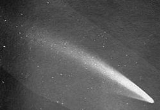
Great Daylight Comet of 1910
Encyclopedia
The Great January Comet of 1910, formally designated C/1910 A1 and often referred to as the Daylight Comet appeared in January 1910. It was already visible to the naked eye
when it was first noticed, and many people independently "discovered" the comet. At its brightest, it outshone the planet Venus
, and was possibly the brightest comet of the 20th century.
only. A number of individuals claimed "discovery", but the comet is thought to have been first spotted by diamond miners in the Transvaal before dawn on January 12, 1910, by which time it was already a prominent naked-eye object of apparent magnitude
-1.
The first astronomer
to properly study the comet was Robert T. A. Innes
at the Transvaal Observatory in Johannesburg
on January 17, after having been alerted two days earlier by the editor of a Johannesburg newspaper.
The comet reached perihelion on January 17 and was at that time visible in daylight with the unaided eye; following perihelion, it declined in brightness but became a spectacular sight from the northern hemisphere
in the evening twilight, its noticeably curved tail reaching up to 50 degrees by early February.
Owing to a "telephonic error," the comet was initially reported as being named Drake's Comet, though once the error was realised the press afterwards referred to it as the Daylight Comet or Sunset Comet, as no single individual was credited with its discovery.
Naked eye
The naked eye is a figure of speech referring to human visual perception unaided by a magnifying or light-collecting optical device, such as a telescope or microscope. Vision corrected to normal acuity using corrective lenses is considered "naked"...
when it was first noticed, and many people independently "discovered" the comet. At its brightest, it outshone the planet Venus
Venus
Venus is the second planet from the Sun, orbiting it every 224.7 Earth days. The planet is named after Venus, the Roman goddess of love and beauty. After the Moon, it is the brightest natural object in the night sky, reaching an apparent magnitude of −4.6, bright enough to cast shadows...
, and was possibly the brightest comet of the 20th century.
Discovery
The comet brightened rather suddenly, and was initially visible from the southern hemisphereSouthern Hemisphere
The Southern Hemisphere is the part of Earth that lies south of the equator. The word hemisphere literally means 'half ball' or "half sphere"...
only. A number of individuals claimed "discovery", but the comet is thought to have been first spotted by diamond miners in the Transvaal before dawn on January 12, 1910, by which time it was already a prominent naked-eye object of apparent magnitude
Apparent magnitude
The apparent magnitude of a celestial body is a measure of its brightness as seen by an observer on Earth, adjusted to the value it would have in the absence of the atmosphere...
-1.
The first astronomer
Astronomer
An astronomer is a scientist who studies celestial bodies such as planets, stars and galaxies.Historically, astronomy was more concerned with the classification and description of phenomena in the sky, while astrophysics attempted to explain these phenomena and the differences between them using...
to properly study the comet was Robert T. A. Innes
Robert T. A. Innes
Robert Thorburn Ayton Innes was a Scottish-South African astronomer best known for discovering Proxima Centauri in 1915, and numerous binary stars. He was also the first astronomer to have seen the Great January Comet of 1910, on January 12...
at the Transvaal Observatory in Johannesburg
Johannesburg
Johannesburg also known as Jozi, Jo'burg or Egoli, is the largest city in South Africa, by population. Johannesburg is the provincial capital of Gauteng, the wealthiest province in South Africa, having the largest economy of any metropolitan region in Sub-Saharan Africa...
on January 17, after having been alerted two days earlier by the editor of a Johannesburg newspaper.
The comet reached perihelion on January 17 and was at that time visible in daylight with the unaided eye; following perihelion, it declined in brightness but became a spectacular sight from the northern hemisphere
Northern Hemisphere
The Northern Hemisphere is the half of a planet that is north of its equator—the word hemisphere literally means “half sphere”. It is also that half of the celestial sphere north of the celestial equator...
in the evening twilight, its noticeably curved tail reaching up to 50 degrees by early February.
Halley's Comet and the Daylight Comet
The year 1910 saw considerable media interest in the predicted return of Halley's Comet, which reached perihelion on April 20. The appearance of the Daylight Comet several months earlier therefore came as something of a surprise, and made an extremely strong impression on an expectant public; when Halley's Comet returned again in 1986, many older people's accounts of having seen it in 1910 clearly referred to the Daylight Comet instead.Owing to a "telephonic error," the comet was initially reported as being named Drake's Comet, though once the error was realised the press afterwards referred to it as the Daylight Comet or Sunset Comet, as no single individual was credited with its discovery.
External links
- JPL Orbit Simulator (Accessed 5/6/08)
- Donald Yeomans, "Great Comets in History". (Accessed 5/6/08)
- The Great Daylight Comet of 1910, by John W. Bortle, Sky and Telescope

